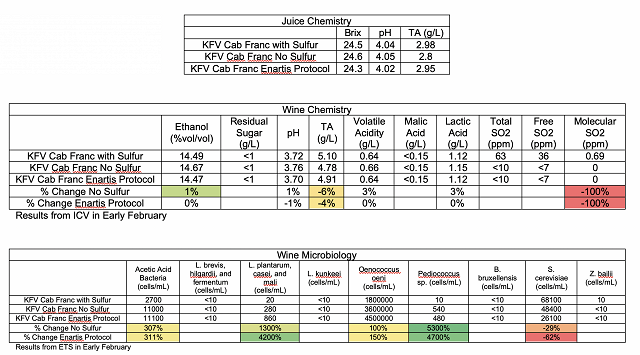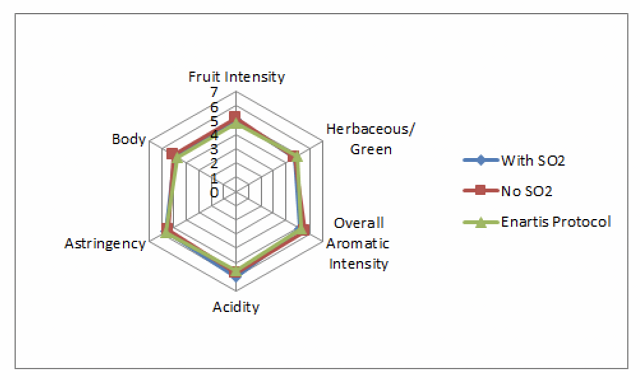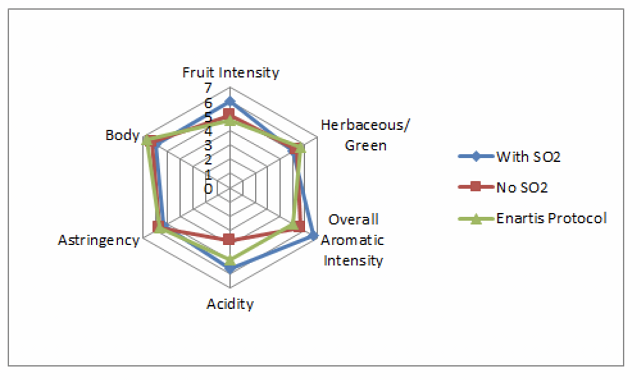No Sulfur Winemaking in Cabernet Franc (2017)
Matthieu Finot
King Family Vineyards
Summary
This study examines the effect of producing wine with and without sulfur dioxide. Cabernet Franc grapes were harvested and processed into 3 separate T Bins. During crush, one treatment received 25ppm sulfur dioxide (control), the second did not receive any sulfur dioxide but instead was protected at crush with Zymaflore Egide, and the third did not receive any sulfur dioxide but instead received Tan Rouge and Stab Micro M during crushing and followed an Enartis no sulfur winemaking protocol. After processing, all wines were inoculated with ES488. One-third through fermentation the Enartis treatment received additions of Pro Tinto and Tan Color. Both no sulfur treatments were inoculated with ML Silver after pressing. At the end of fermentation, the control wine was stabilized with sulfur dioxide, the no sulfur wine received Stab Micro, and the Enartis protocol received additions of Surli Round, Tan SLI, and Stab Micro M. Wine chemistry is similar between treatments, except that no sulfur winemaking resulted in slightly lower TA. Both no sulfur winemaking wines had higher levels of acetic acid bacteria, lactic acid bacteria, and Pediococcus. Color intensity was higher due to a lack of sulfite bleaching. Overall, Cabernet Franc produced with sulfur dioxide tended to have higher perceived Acidity. Other differences between wines were not easy to distinguish with the descriptors used in this study, but the no sulfur wine and the wine with sulfur dioxide may have had slightly higher Overall Aromatic Intensity and Fruit Intensity. The wine made with sulfur dioxide tended to be most preferred, followed by the wine without sulfur dioxide. Conclusions are difficult to draw at this point. Many more studies are needed on no sulfur winemaking in red wines and its impact on sensory qualities. Additionally, more studies are needed to examine how aging is affected by no sulfur winemaking.
Introduction
Producing wine without sulfur dioxide can have an impact on wine flavor and style. Furthermore, no sulfur wines may have marketability niches for consumers. However, no sulfur winemaking also carries with it many risks. No sulfur wines are at greater risk for microbial spoilage, and no sulfur wines are also more prone to perceptible oxidation compared to wines produced with sulfur dioxide. These challenges can be mitigated in part by many procedural factors, such as through using clean grapes, rigorous cellar cleanliness, keeping pH low, fermenting to high alcohol, careful oxygen and inert gas management, and prudent aging practices to minimize oxidative and microbial spoilage. Furthermore, several enological products can be added during different stages of the winemaking process to further reduce spoilage chances. For example, sacrificial tannin or glutathione may be added to help protect the wine against oxidation, and certain additives such as chitosan and lysozyme may further help reduce microbial spoilage risk or intensity. This study compares three different winemaking techniques and their impact on resulting red wine quality: traditional sulfur dioxide usage, no sulfur dioxide usage, and an Enartis protocol involving the use of sacrificial tannin and microbial fining agents.
Results and Discussion
Wine chemistry was similar between treatments, except that no sulfur winemaking resulted in slightly lower TA. Both no sulfur winemaking wines had higher levels of acetic acid bacteria, lactic acid bacteria, and Pediococcus. Color intensity was higher due to a lack of sulfite bleaching.


For the descriptive analysis on February 28, there was a strong tendency for Acidity to be different between wines, with the wine With SO2 having higher perceived Acidity than the wines without SO2 (LSD=0.19). There was a slight tendency for the no sulfur treatment to have higher Overall Aromatic Intensity. There were no strong preference trends between treatments.


For the March 14 tasting, the wine made with sulfur dioxide tended to have higher Fruit Intensity, Overall Aromatic Intensity, and Acidity. Preferences were hard to distinguish. There were very few judges at this tasting, and so sensory results are very uncertain.

Overall, Cabernet Franc produced with sulfur dioxide tended to have higher perceived Acidity. Other differences between wines were not easy to distinguish with the descriptors used in this study, but the no sulfur wine and the wine with sulfur dioxide may have had slightly higher Aromatic intensity and Fruit Intensity. The wine made with sulfur dioxide tended to be most preferred, followed by the wine without sulfur dioxide. Conclusions are difficult to draw at this point. Many more studies are needed on no sulfur winemaking in red wines and its impact on sensory qualities. Additionally, more studies are needed to examine how aging is affected by no sulfur winemaking.
Methods
Cabernet Franc grapes were harvested on October 4, 2017 and refrigerated overnight. The following day the grapes were processed into 3 separate bins, and during crush received:
- 25ppm sulfur dioxide added (control)
- No sulfur dioxide added but instead 30g Zymaflore Egide (in 558L must) added during crush
- Enartis no sulfur protocol (Enartis 2017), with 110g Tan Rouge and 110g Stab Micro M (in 558L must) added during crush
After processing, later in the day, the must was inoculated with 13g/hL ES488. On October 6, 0.05g/L Lafase HE Grand Cru was added to the control wine. 0.3g/L malic acid and 1.5g/L tartaric acid were added to each must on this date as well. On October 11, the Enartis Protocol wine received 0.2g/L each of Pro Tinto and Tan Color (one-third through fermentation). On October 18, 0.2g/L malic acid and 1g/L tartaric acid were added to each wine. Wines were pressed on October 23 into tank, settled overnight, and then racked to identical barrels. The no sulfur and Enartis Protocol wines received 0.005g/L ML Silver, and 0.02g/L Nutriferm Osmobacti on October 23. On November 23, 1 g/L tartaric acid was added to the wine. On November 23 the Enartis protocol wine also received 0.4g/L Surli Round, 0.02g/L Tan SLI, and 0.033g/L Stab Micro M. The no sulfur wine also received stab micro on this date. On January 5, each wine received 0.33g/L tartaric acid. The control wine also received 66ppm sulfur dioxide and 0.03g/L Stab micro at this time.
These wines were tasted on February 28 and March 14. In order to balance the data set to perform statistical analysis for descriptive analysis on the February 28 tasting, any judge who had not fully completed the descriptive analysis ratings were removed. In order to then make the number of judges between groups equivalent, one judge from group 2 was transferred to group 3, and another judge from groups 1 and 2 was eliminated. This resulted in a final data set of 3 groups, each with 8 judges (considered as replications within groups, and groups were considered as assessors). Data was analyzed using Panel Check V1.4.2. Because this is not a truly statistical set-up, any results which are found to be statistically significant (p<0.05) will be denoted as a “strong trend” or a “strong tendency,” as opposed to general trends or tendencies. The statistical significance here will ignore any other significant effects or interactions which may confound the results (such as a statistically significant interaction of Judge x Wine confounding a significant result from Wine alone). The descriptors used in this study were Fruit Intensity, Herbaceous/Green, Overall Aromatic Intensity, Acidity, Astringency, and Body.
Due to the very small number of judges (3) at the March 14 tasting, only slight trends will be discussed for the sensory information. No statistical analysis was performed.
References
Enartis. 2017. Winemaking protocol: Low/No SO2 wines – red. 2017 Vintage. Enartis USA.
